Some of the heaviest animals still roaming wild in England are impressive. But England is not known for its large wild animals. Many large animals, such as wolves and bears, have gone extinct centuries ago due to overhunting. Nonetheless, present day, some large animals still reside here, roaming freely and mesmerizing wildlife admirers. These majestic animals, which all happen to be mammals, showcase their impressive size and grace in woodlands, meadows, and coastal areas. There are also a variety of conservation efforts in place to protect many of these species on our list. Each of these remarkable creatures enriches England’s biodiversity and heritage. Let’s explore them!

Red deer are among the heaviest animals still roaming wild in England.
©Andrew Swinbank/Shutterstock.com
Grey Seal (Halichoerus grypus)
The grey seal is the first on our list and the heaviest animal still roaming wild in England. Adult males are often called bulls. Females are called cows. Adults weigh around 220 to 660 pounds (100 to 300 kilograms). They can reach a length on average of 8.5 feet (2.6 meters). Female grey seals are also generally smaller than males.
This magnificent marine mammal exhibits a robust and smooth body, adorned with a coat that varies from light to dark gray, with distinctive spots or blotches and brown hues. The grey seal’s large, dark eyes lend an inquisitive expression to its face. Both male and female grey seals have two short flipper forelimbs and hind flippers.
As carnivorous predators, grey seals have a diet consisting primarily of fish but also crustaceans, squid, octopus, and sometimes even seabirds. They are skilled hunters, using their excellent underwater vision and agility to catch their prey.
Distribution and Preferred Habitat
Grey seals reside along the coastlines of England, where they inhabit a variety of locations, including sandy and rocky shores, estuaries, and offshore islands. They form breeding colonies, or rookeries, in secluded spots along the coastline.
The grey seal prefers a coastal habitat that provides easy access to the sea for foraging and breeding. They commonly utilize sandy and rocky beaches as resting places. At the same time, offshore islands often serve as breeding grounds during the pupping season.
Conservation Status
The grey seal holds a conservation status of least concern with the International Union for Conservation of Nature (IUCN) Red List. There are protection measures in place to safeguard their populations, habitats, and breeding areas, such as the Conservation of Seals (Britain) Act 1970, the Wildlife (Northern Ireland) Order 1985, and the Marine (Scotland) Act 2010.
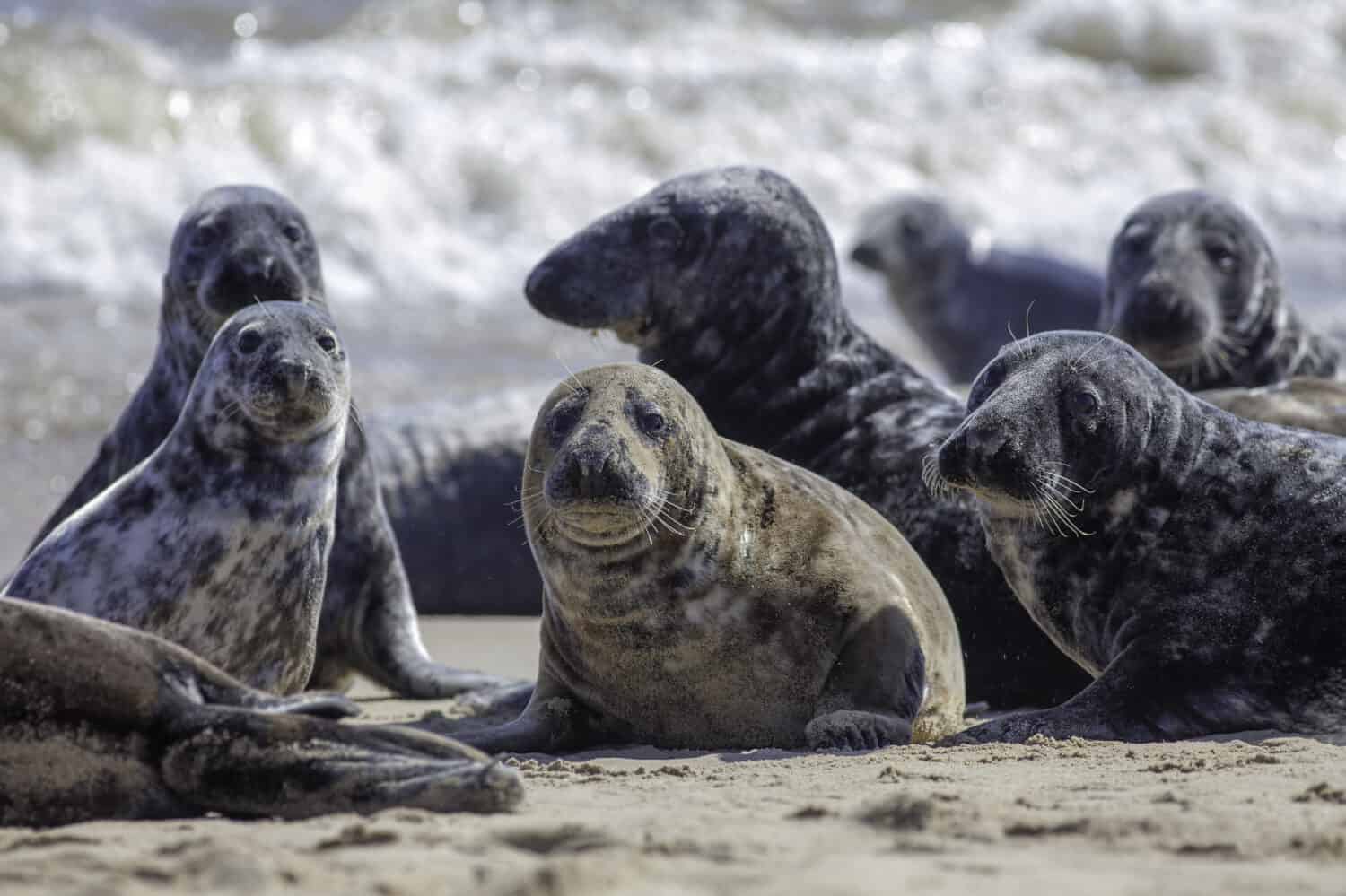
Grey seals can grow to considerable sizes, reaching weights upwards of 660 pounds (300 kilograms).
©Ian Dyball/Shutterstock.com
Red Deer (Cervus elaphus)
The red deer is one of the heaviest animals still roaming wild in England today, making it a true giant. Red deer weigh up to 440 pounds (199 kilograms) or more. Stags stand 48 inches (122 centimeters) high at the shoulder. Female deer, known as hinds, are relatively smaller, with an average height of 45 inches (114 centimeters).
The red deer exhibits a striking appearance, adorned with a coat that changes with the seasons. During the summer, its fur showcases a reddish-brown hue, while it transitions to more grayish-brown tones in winter. One notable feature is the conspicuous yellow rump patch, which becomes particularly visible during seasonal changes going into winter. Stags stand out with their magnificent antlers and luscious manes, branching out with multiple points and extending up to 28 to 45 inches (71 to 115 centimeters), adding to their regal appearance.
They follow a herbivorous diet, relying on plants for sustenance. Their food preferences vary depending on the season, including grasses, heather, sedges, young shoots, leaves, and shrubs. In times of scarcity during winter, they may resort to consuming bark and woody vegetation to survive.
Distribution and Preferred Habitat
These grand creatures reside in various regions across England, thriving in diverse landscapes. They reside in much of England, Wales, Northern England, southern Scotland, and the Scottish Highlands.
Red deer seek habitats that provide an optimal balance of grazing areas and dense vegetation for shelter. Woodlands, moorlands, and grasslands are the preferred habitats of these majestic creatures. They frequent areas with access to water sources, such as rivers or streams, to fulfill their hydration needs. You can most commonly spot them in woodland and on the open hills and moors if you’re searching for them. Their adaptability allows them to inhabit various environments.
Conservation Status
The red deer has a conservation status of least concern on the IUCN Red List. This species is actually on the rise, too. Red deer are native to the British Isles, including England, and have historically been present in various regions. Red deer populations are managed to some extent through conservation programs and hunting regulations. This is to ensure their numbers remain stable and in balance with the environment. Various wildlife and conservation laws protect them. For example, the United Kingdom protects them under the Deer Act 1991.
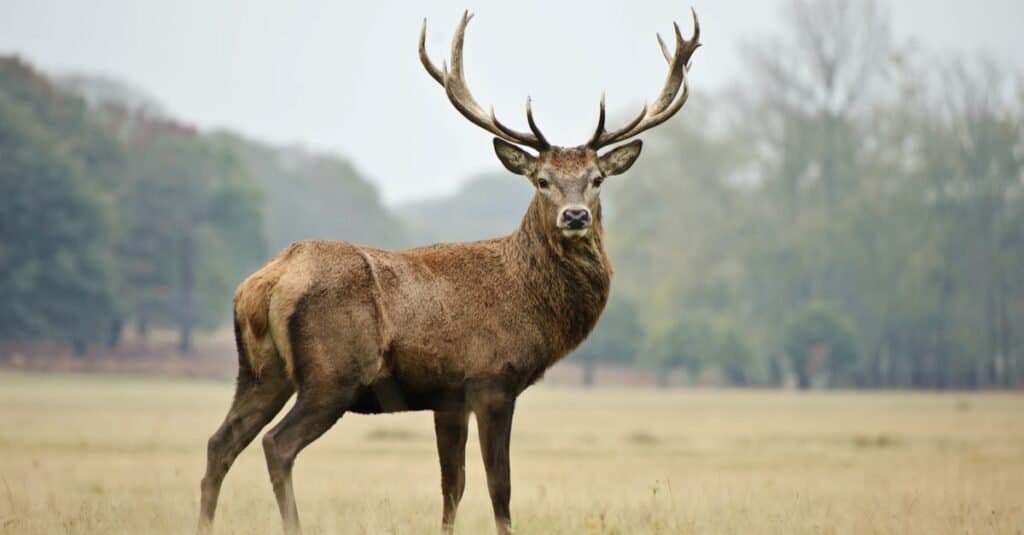
Red deer often achieve weights upwards of 440 pounds (199 kilograms).
©iStock.com/Matt_Gibson
Eurasian Wild Boar (Sus scrofa)
The Eurasian wild boar is indeed a true heavyweight, with adult males, commonly called boars, weighing around 130 to 440 pounds (60 to 200 kilograms). They stand at an average height of approximately 32 inches (70 centimeters) at the shoulder. Female wild boars, known as sows, are generally smaller.
This brutal animal has a robust and muscular build, displaying a coat that can vary from dark brown to black, with bristle-like hairs. One of their most distinctive features is the pair of prominent tusks, which curve upwards from their mouths. Both males and females can have tusks, though the males’ grow larger. These tusks are elongated canine teeth and are more prominent in males than females.
As omnivores, wild boars have a diverse diet that includes roots, tubers, berries, nuts, and various types of vegetation. They also consume insects, small animals, invertebrates, earthworms, and carrion, making them opportunistic feeders.
Distribution and Preferred Habitat
Wild boars reside in various regions across England, where they roam in woodlands, forests, and open fields. The current population stretches across the United Kingdom. It is a result of captive animals that escaped or were released illegally. There are approximately 2,600 individuals in the United Kingdom. Most of which reside in populations in the Forest of Dean. You can spot wild boars in parts of southeast England, southwest England, southeast Wales, and northwest Scotland.
Wild boars prefer habitats that offer a mix of woodlands and open areas, providing abundant food and cover. They are incredibly adaptable animals and can thrive in various environments, including deciduous and coniferous forests and areas with dense undergrowth.
Conservation Status
The wild boar has a conservation status of least concern on the IUCN Red List. Wild boar populations in England are relatively stable. Yet, the accidental reintroduction of their presence isn’t necessarily desired as they are pretty destructive and aggressive.
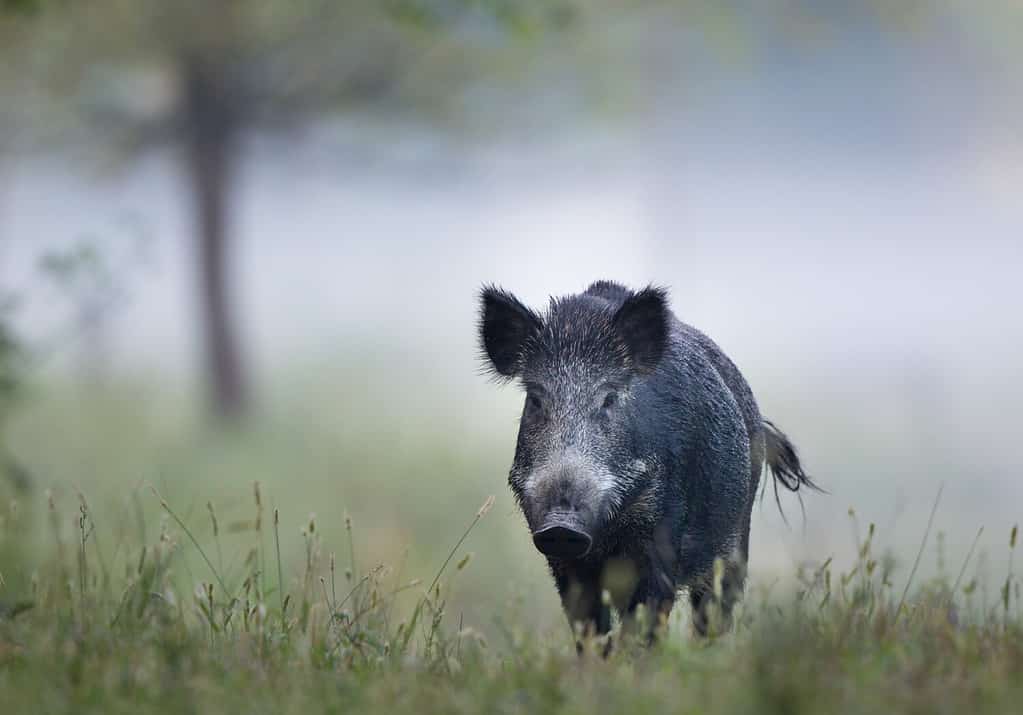
Eurasian wild boars are one of the heaviest animals still roaming wild in England, weighing an average of 130 to 440 pounds (60 to 200 kilograms).
©Budimir Jevtic/Shutterstock.com
Common Seal (Phoca vitulina)
The common seal is another seal on our list of heaviest animals still roaming wild in England. Adult individuals weighing around 140 to 330 pounds (65 to 150 kilograms). They reach an average length of approximately 6.5 feet (2 meters). Male and female common seals are generally similar in size, with minimal sexual dimorphism.
The common seal is much smaller than the grey seal, but they also exhibit a sleek and streamlined body. The common seal’s coat is short and dense, typically varying in color from blonde to black, though most commonly gray with dark brown spots. Another differentiating factor from grey seals is that common seals have V-shaped nostrils. Their large, dark eyes convey an endearing and curious expression. Unlike other seal species, common seals have no external ear flaps, giving their heads a rounded appearance. This also classifies them as “true seals.”
As carnivorous predators, common seals have a diet mainly consisting of fish, including herring, cod, and flatfish, in addition to whelks, crabs, and mussels. They are skilled hunters in the sea, using their excellent underwater vision and agile swimming to catch their prey.
Distribution and Preferred Habitat
The common seal resides along the coastlines of England in many similar places to grey seals. They include rocky shores, sandbanks, estuaries, and sheltered bays. You can spot them around eastern England, Scotland, Northern Ireland, and Teesmouth coasts.
Common seals prefer coastal habitats as they need access to both land and sea. They reside in areas where they can easily haul out of the water to rest, breed, or give birth to their pups. Sheltered bays, estuaries, and rocky shores provide ideal locations for these seals to rest and rear their young.
Conservation Status
The common seal has a conservation status of least concern on the IUCN Red List. There are various conservation efforts in place to protect common seals. They include the Conservation of Seals (Britain) Act 1970, the Wildlife (Northern Ireland) Order 1985, and classified as a Priority Species under the UK Post-2010 Biodiversity Framework.

The common seal is one of the heaviest animals still roaming wild in England, in addition to being one of the cutest. They weigh approximately 140 to 330 pounds (65 to 150 kilograms).
©Iwona Fijol/Shutterstock.com
Fallow Deer (Dama dama)
The fallow deer, or more specifically, the European fallow deer, boasts a substantial size as one of the heaviest animals still roaming wild in England. Adult males, commonly called bucks, weigh around 130 to 330 pounds (58 to 150 kilograms). They stand tall at the shoulder, reaching heights of approximately 33 to 37 inches (85 to 95 centimeters). Female deer, also known as does, is relatively smaller, with an average weight of about 66 to 110 pounds (30 to 50 kilograms) and a height of 30 to 33 inches (75 to 85 centimeters).
This delightful deer exhibits a striking and diverse coat coloration, which can vary among individuals. The typical coat colors include shades of brown, chestnut, black, or near-white, and sometimes paired with white spots or mottles. The fallow deer’s most distinctive feature is the palmate shape of its antlers, which are broad and shovel-shaped. These impressive antlers are found in males and are shed and regrown annually.
As herbivores, fallow deer primarily feed on a vegetarian diet. Their food choices include grasses, herbs, shrubs, leaves, and berries. When food is scarce in the winter, they may also consume tree bark and fungi to sustain themselves.
Distribution in England and Preferred Habitat
Fallow deer reside in various regions across England, Wales, southern Scotland, and Ireland. This makes them a well-known and cherished sight. They inhabit areas such as parklands, woodlands, grasslands, and farmland.
Fallow deer prefer habitats that offer a combination of open grazing spaces and ample shelter cover. Woodlands with clearings, grassy meadows, and areas near water sources suit their needs well. They adapt well to parkland environments. And they can often be seen near human settlements.
Conservation Status
On the IUCN Red List, fallow deer are listed with a status of least concern. Fallow deer are widespread and have stable populations in many regions, including parts of Europe, Central America, Africa, and North America, where they have been introduced. They are adaptable animals and can thrive in various habitats, contributing to their robust numbers. In some areas worldwide, fallow deer populations may be managed to control their numbers and minimize potential conflicts with agriculture or other human activities. However, overall, the species has a healthy and stable population in its range.
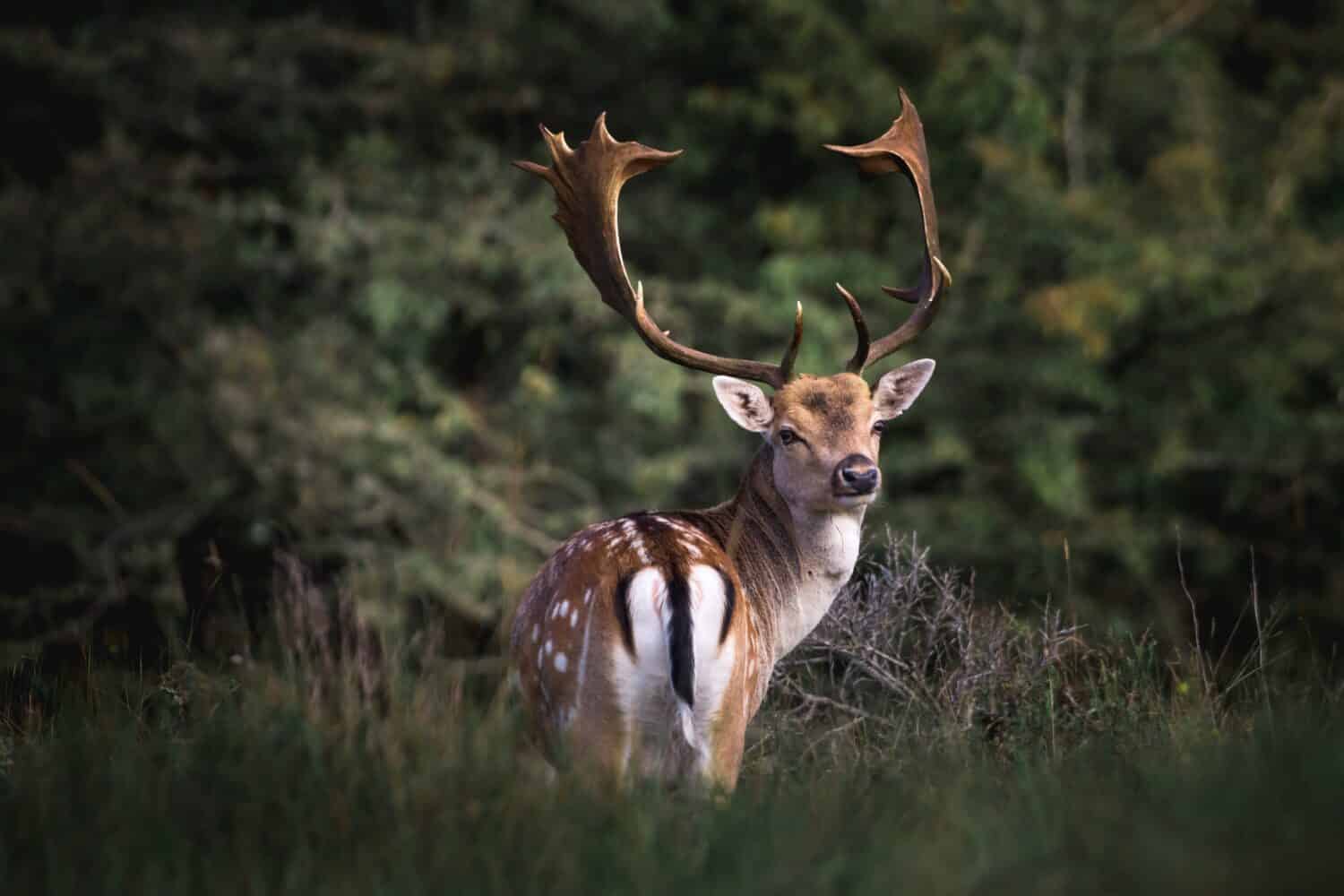
Fallow deer are the second largest species of deer in England, weighing in at 130 to 330 pounds (58 to 150 kilograms).
©Jolanda Aalbers/Shutterstock.com
Roe Deer (Capreolus capreolus)
The roe deer boasts a moderate size, with adults weighing around 35 to 65 pounds (15 to 35 kilograms). At shoulder height, they stand at approximately 24 inches (61 centimeters).
Roe deer exhibit a beautiful coat with a reddish-brown in summer and grayish-brown coloration in winter, which can vary among individuals. Roe deer have a distinctive cream-white rump patch. Males have short antlers with, usually, no more than three points. During winter, their coat becomes denser to provide extra insulation against the cold.
As herbivores, roe deer feed on a vegetarian diet. Their food preferences vary with the seasons, including grasses, herbs, leaves, berries, young shoots, and buds. They are selective feeders, consuming diverse plant species to meet their nutritional needs.
Distribution in England and Preferred Habitat
The roe deer reside in various regions across England, making it a well-known and cherished sight. They inhabit a variety of landscapes, including woodlands, grasslands, and farmlands. As they are so widespread, you will likely spot them almost anywhere outside major cities.
Roe deer thrive in habitats that offer a mix of open spaces for grazing and dense cover for shelter. They reside in woodlands with clearings, fields, and hedgerows that provide suitable foraging opportunities. Roe deer are highly adaptable and can coexist near human settlements, making them familiar in rural and suburban areas.
Conservation Status
Like the other deer we have explored on our list, the roe deer has a conservation status of least concern on the IUCN Red List. They are not currently facing a significant risk of extinction in the wild. Roe deer populations in England remain stable, benefiting from various conservation efforts and their ability to adapt to different environments.
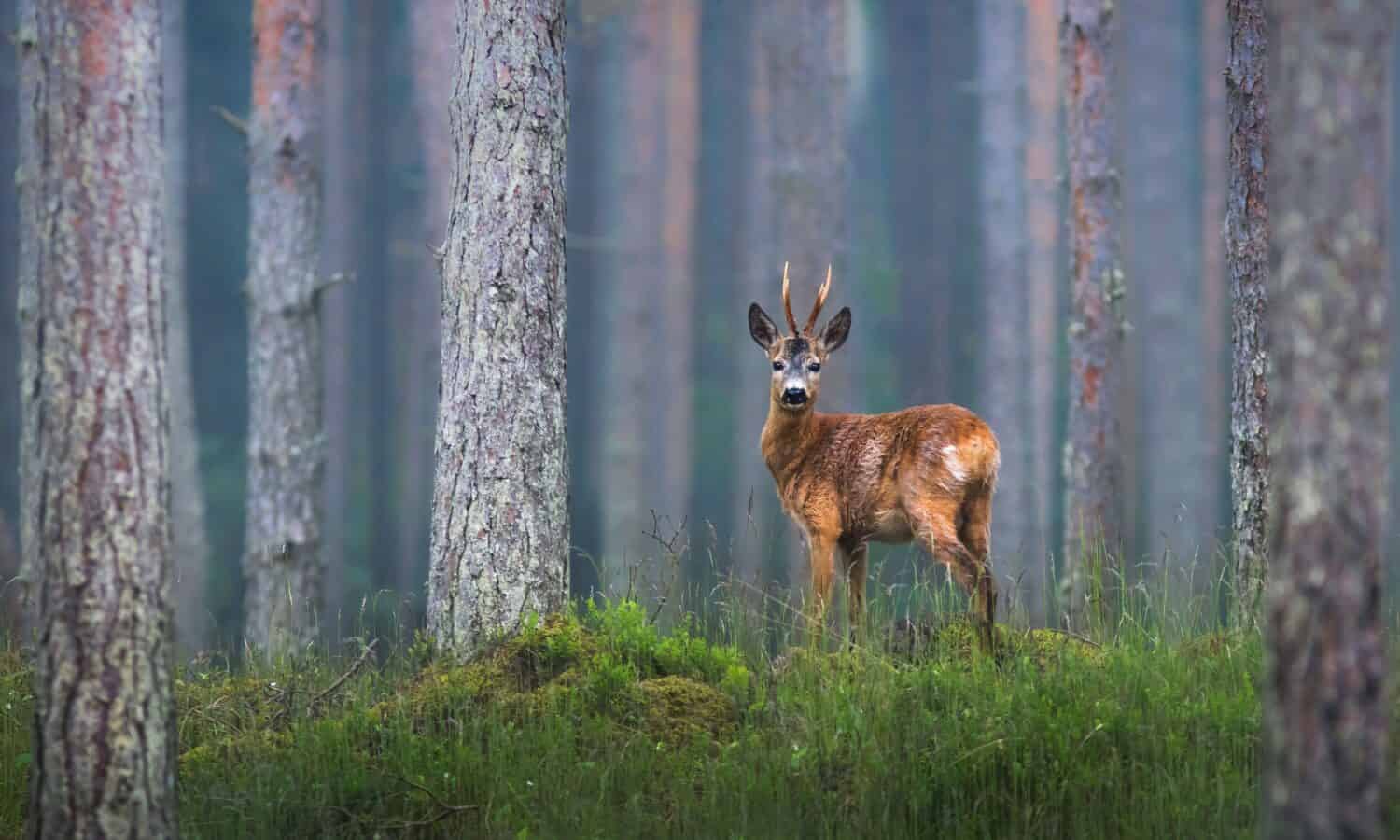
Roe deer are much smaller than fallow deer and red deer, weighing on average 35 to 65 pounds (15 to 35 kilograms).
©Edgar Smislov/Shutterstock.com
Eurasian Badger (Meles meles)
The last and smallest on our list of heaviest animals still roaming wild in England is the Eurasian badger. Adults weigh around 17 to 37 pounds (8 to 17 kilograms). Eurasian badgers are relatively low to the ground, with short legs and a sturdy build.
They have a distinctive appearance with a coat with hues of predominantly gray but also black, white, and brown mixed in, featuring a black and white striped face. Moreover, they have a small head, a stocky body, small black eyes, and a short tail. Eurasian badgers have sharp claws and powerful forelimbs, well-suited for digging burrows and foraging.
As omnivorous creatures, Eurasian badgers have a varied diet, including earthworms, slugs, snails, other insects, small mammals, birds’ eggs, fruits, nuts, seeds, and roots. They are skilled foragers, using their keen sense of smell to locate food in the ground and using their strong claws to dig.
Distribution and Preferred Habitat
These powerful creatures reside all across England. They reside in many landscapes, including woodlands, hedgerows, grasslands, farmland, and even urban areas. They are highly adaptable species that can thrive in diverse environments.
Eurasian badgers prefer habitats that offer a mix of woodlands and open areas, providing both shelter and easy access to foraging grounds. They dig complex underground burrows, called setts, which serve as their homes and provide protection from predators and harsh weather conditions.
Conservation Status
The Eurasian badger is listed on the IUCN Red List as a species of least concern. The United Kingdom protects the Eurasian badger under two prominent acts, which include the Protection of Badgers Act 1992 and the Wildlife and Countryside Act 1981.

Eurasian badgers weigh an average of 17 to 37 pounds (8 to 17 kilograms), making them the smallest animal on our list of the heaviest animals still roaming wild in England.
©Ondrej Prosicky/Shutterstock.com
Summary of the 7 Heaviest Animals Still Roaming Wild in England
| Rank | Animal | Average Weight |
|---|---|---|
| 1 | Grey Seal | 220 to 660 pounds (100 to 300 kilograms) |
| 2 | Red Deer | Up to 440 pounds (199 kilograms) or more |
| 3 | Eurasian Wild Boar | 130 to 440 pounds (60 to 200 kilograms) |
| 4 | Common Seal | 140 to 330 pounds (65 to 150 kilograms) |
| 5 | Fallow Deer | 130 to 330 pounds (58 to 150 kilograms) |
| 6 | Roe Deer | 35 to 65 pounds (15 to 35 kilograms) |
| 7 | Eurasian Badger | 17 to 37 pounds (8 to 17 kilograms) |
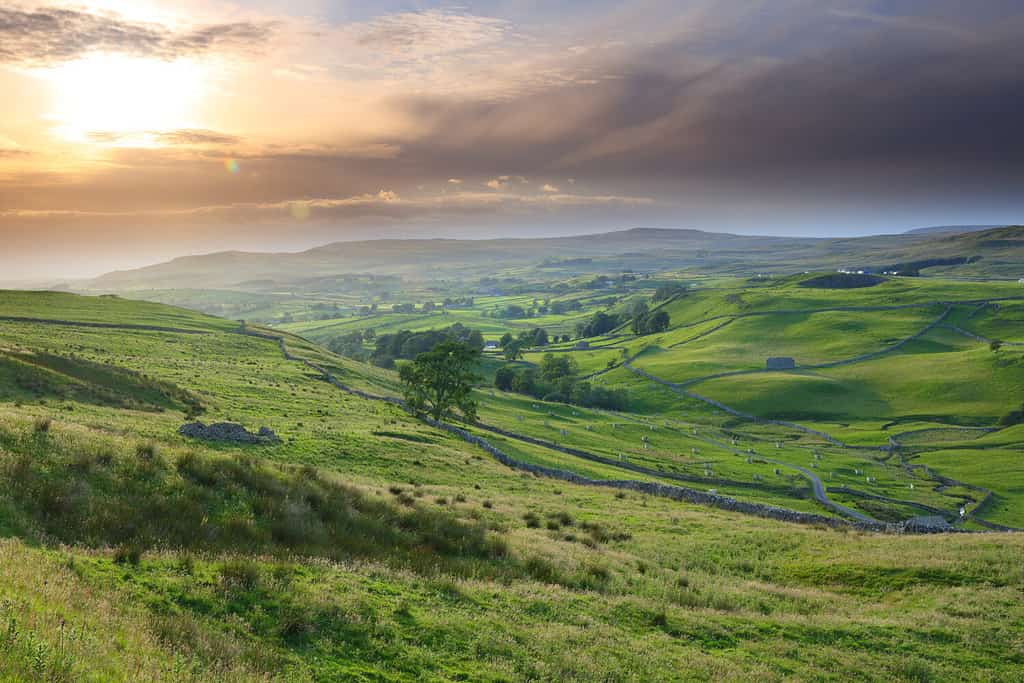
England is home to a diverse landscape that once homed heavy animals such as wolves and bears. However, due to overhunting, they went extinct hundreds of years ago.
©Colin Ward/Shutterstock.com
Conclusion
To conclude, of the heaviest animals still roaming wild in England, seven stand out as the largest. Deer are some of the heaviest animals in England, including the red deer, fallow deer, and roe deer. Each showcases their majesty with their unique size. Venturing south, the Eurasian wild boar impresses with its substantial weight. The coastal wonders, including the common seal and grey seal, also hold a position as some of the heaviest animals. Amidst diverse habitats across England, the powerful Eurasian badger thrives, making its mark as the lightest of animals on our list. Many are protected by conservation efforts.
The photo featured at the top of this post is © Andrew Swinbank/Shutterstock.com
Thank you for reading! Have some feedback for us? Contact the AZ Animals editorial team.







